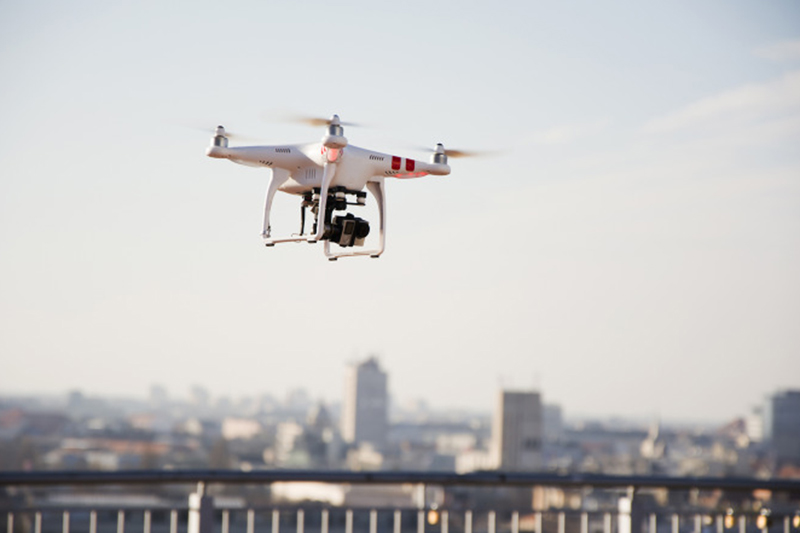
Everyone, it seems, has an opinion about “Unmanned Aerial Systems,” more popularly known as drones. From hobbyists to cinematographers to hunters to roofers such as National Roofing Partners, the technology, which allows small, unmanned and remotely controlled flying machines to get a bird’s eye view of everything below, is fascinating to users but vexing to privacy and air-safety advocates.
For every drone advocate, there is someone below it who resents the intrusion of these pesky machines. To make matters worse, federal, state and local authorities are confused about their respective roles in managing this new technology because there are no regulations in place at the present time. According to a front-page article in the Wall Street Journal, at least 17 states have “passed laws to restrict how law enforcement and private citizens use the devices – preemptive policies that many drone users say are heavy-handed.”
The federal authority – the Federal Aviation Administration (FAA) – says it alone has the right to regulate U.S. skies. However, this has not stopped cities such as Austin, Texas from banning the devices during the annual South by Southwest technology and music event. Since the 1930’s, planes have been prohibited from flying below 500 feet and this space was relatively free of traffic, save for a kite or model airplane. Now, there are thousands of drones in this airspace; some being used to spy on the neighbors next door and some being used for commercial purposes such as investigating the source of a leak on the roof of a building.
Drones: A New Tool for the Roofing Industry
“Even though the use of drones in the roofing industry is not yet legal and requires specific permission from the FAA, we have heard that there are contractors actively employing this tool,” noted Heidi Ellsworth of EagleView Technologies, a company which specializes in visual analysis of roofs for the insurance and roofing industries. “Once these legal issues are clarified, we see drones as being an excellent tool for gathering video and incorporating imagery into current workflows.
The roofing industry trade organization, The National Roofing Contractors Association (NRCA), recently submitted comments to the FAA regarding its proposed regulation that would allow for the commercial use of drones. NRCA generally supports the proposed regulation, which is designed to incorporate the commercial use of small drones (those weighing 55 pounds or less) into the national airspace in a safe manner under a consistent set of rules for all commercial users.
Among other things, the proposed FAA rules would require operators of small drones to be certified, and their flight would be limited to a maximum height of 500 feet. NRCA’s comments contained several suggestions for changes in the proposed rule to maximize the use of small drones for roof inspections. It is expected the FAA will issue a final regulation sometime during the next two years.
Aerial Imagery Provides Much Needed Data on Roofs
Safety and privacy issues aside, the best commercial use of drones for the roofing industry will involve the efficient capture of the aerial imagery. This requires the cameras and processes that enable the high-resolution and geo-coded accuracy, according to Heidi Ellsworth.
“EagleView Technologies, utilizing our patented Pictometry® image technology, continues to focus on image capture and the subsequent data extraction from that imagery,” she noted. “The use of drones holds potential for capturing higher resolution imagery than ever before.”
The company uses its fleet of 85 planes to capture this roof-top imagery across the United States and works with National Roofing Partners. It has also created an industry group to help determine the best practices for the use of drones in the roofing industry.
EagleView has led the formation of the Property Drone Consortium (PDC). This group represents a collaboration among insurance carriers, construction industry leaders and supporting enterprises that have agreed to work together to promote research, development and the establishment of regulations for the use of drone technology across the insurance and construction industries.
As an independent, third-party technology provider and industry innovator in the capture of aerial imagery, EagleView has agreed to provide its research and development expertise to the consortium. “With over twenty years of developing aerial solutions that capture property information, EagleView believes it can utilize patented Pictometry image technologies to further the safe, efficient and scalable use of drone technology for property data collection,” stated Chris Barrow, president, and CEO of EagleView.
There is no doubt drones will eventually be used in the roofing industry. The only questions concern the rules and regulations associated with their use. When this happens, National Roofing Partners will add this technology to its arsenal and customers will reap the benefits of this eye in the sky.
This blog first appeared on National Roofing Partners’ blog and can be viewed here.
